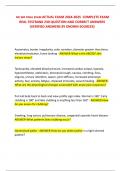NR 304 FINAL EXAM ACTUAL EXAM 2024-2025
COMPLETE EXAM
REAL TESTBANK 230 QUESTION AND CORRECT ANSWERS
(VERIFIED ANSWERS BY KNOWN SOURCES)
Asymmetry, border irregularity, color variation, diameter greater than 6mm,
elevation/evolution, funny looking - ANSWER-What is the ABCDEF skin
lesions mean?
Tachycardia, elevated blood pressure, increased cardiac output, hypoxia,
hypoventilation, atelectasis, decreased cough, nausea, vomiting, ileus,
oliguria, urinary retention, spasm, joint stiffness, increased adrenergic
activity, fear, anxiety, fatigue, impaired immunity, wound healing - ANSWER-
What are the physiological changes associated with acute pain responses?
Put nail beds back to back and view profile sign index. Normal is 160°. Early
clubbing is 180° and lake clubbing is anything less than 160° - ANSWER-How
do you assess for clubbing?
Smoking, lung cancer, pulmonary disease, congenital cyanotic heart disease -
ANSWER-What patients does clubbing occur?
Generalized pallor - ANSWER-How do you detect pallor in a light skinned
patient?
,Ashen gray, dull, loss of glow, cool to palpation - ANSWER-How do you detect
pallor in a dark skinned patient?
Yellow sclera, hard palate, skin, mucous membranes - ANSWER-How do you
detect jaundice in a light-skinned patient?
Observe the palms, hard and soft palates - ANSWER-How do you observe
jaundice in a dark skinned patient?
Dusky blue appearance - ANSWER-How do you observe cyanosis in a light
skinned patient?
Dullness, check conjunctiva, oral cavity, nails - ANSWER-How do you observe
cyanosis in a dark skinned patient?
Red or bright pink color - ANSWER-How do you observe erythema in a light
skin patient?
Purpleish tinge, difficult to observe, palpate for warmth - ANSWER-How do
you observe erythema in a dark skinned patient?
Stage 1 non-blanchable erythema
Intact skin with a localized area of non-blanchable erythema - ANSWER-
What is the name and characteristics of a stage one pressure injury?
,Stage 2 partial thickness skin loss
Partial skin loss with an exposed dermis. Pink/red and moist visible wound
base. Looks like a ruptured blister. Usually associated with moisture. Slough
and eschar not noted. - ANSWER-What is the name and characteristics of a
stage 2 pressure injury?
Stage 3: Full-Thickness Skin Loss
For thickness loss of skin. Adipose is visible in ulcer and granulation tissue
with epibole. Slough and eschar may be noted. Tunneling and undermining
may occur. - ANSWER-What is the name and characteristics of a stage 3
pressure injury?
Stage 4: Full thickness skin/tissue loss
Full thickness skin and tissue loss with muscle/bone/tendon/ligament
exposed. Slough, Eschar, epibole, undermining, tunneling may be present. -
ANSWER-What's the name and characteristic of a stage 4 pressure injury?
Touch chin to chest, turn head right and left, touch ear with shoulder
without elevating the shoulders, extend head backwards - ANSWER-How do
you assess the range of motion of the neck?
Non-pitting Edema, fatigue, cold intolerance, puffy Edematous face, Peri
orbital Edema, puffy hands/feet, course facial/hair features, cool/dry skin,
slow reflexes, occasionally thick speech. - ANSWER-What are the
manifestations of hypothyroidism?
, Progress towards outcomes, use ongoing assessment to revise
diagnoses/outcomes/plans, disseminate results to patient and family -
ANSWER-What happens during the evaluation step of the nursing process?
Compare clinical findings with normal and abnormal variation and
developmental events, interpret data, validate and document diagnoses. -
ANSWER-What happens during the diagnosis stage of the nursing process?
For limited or short term problems. Collect mini/targeted databases. Focuses
on only one problem or body system and is used in all clinical settings.
Ex: two days post-op patient suddenly becomes SOB with congestive cough
and fatigue; focus on respiratory and cardiovascular systems - ANSWER-
What is a problem center database? Give an example.
Begins during first patient encounter.. Includes their physical appearance,
body structure, mobility, behavior, body measurements - ANSWER-What are
the components of a general survey?
3+ Full, bounding
2+ Normal
1+ Weak, thready
0 Absent - ANSWER-What is the grading of pulse force?
Acute myocardial infarction, shock, hemorrhage, vasodilation, Addison's
disease - ANSWER-What are causes of hypotension?




